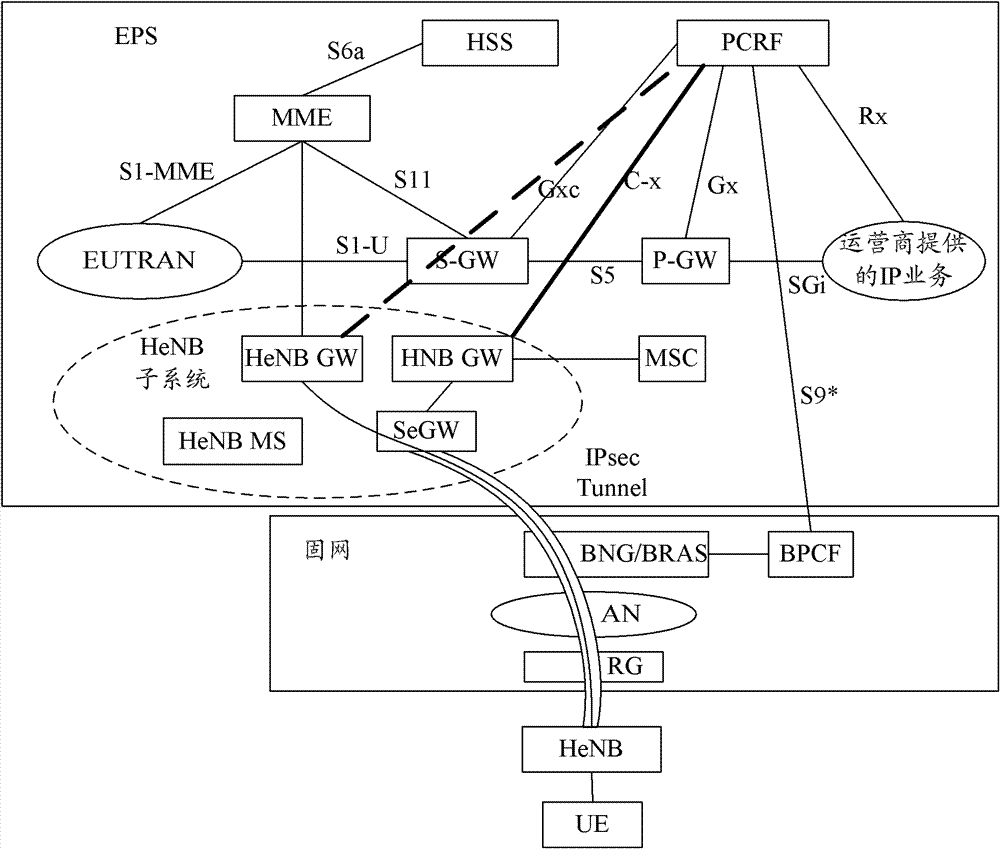A method and system for implementing admission control
A technology of admission control and implementation method, applied in the directions of access restriction, transmission system, network flow/resource management, etc., which can solve the problems that CSG users cannot carry out services and provide QoS guarantees, etc.
- Summary
- Abstract
- Description
- Claims
- Application Information
AI Technical Summary
Problems solved by technology
Method used
Image
Examples
Embodiment 1
[0081] The application scenario of this embodiment is: when the admission control result of the BPCF to the user is rejection, the HeNB performs the second admission control on the user according to the CSG information and the ARP information (that is, the HeNB performs resource preemption according to the CSG information and the ARP information ). Wherein, the user's CSG information is obtained when the UE accesses the HeNB.
[0082] The preconditions for the application of this embodiment are: assuming that user A is a CSG user and user B is a non-CSG user, the resource preemption capability of user A is lower than that of user B, that is, the ARP priority of user A is lower, and the resource preemption capability of user B is lower than that of user B. The priority of user B is higher; user B has started the service, and the network (fixed network and mobile network) has allocated resources for user B to start the service. The HeNB-authorized QoS has been occupied by user ...
Embodiment 2
[0102] When the admission control result of the BPCF to the user is rejection, the HeNB performs the second admission control on the user according to the CSG information and the ARP information (that is, the HeNB performs resource preemption according to the CSG information and the ARP information). Wherein, the user's CSG information is obtained when the UE accesses the HeNB.
[0103] The prerequisite for the application of this embodiment is as follows: assume that user A is a non-CSG user, user B is a CSG user, and the resource preemption capability of user A is lower than that of user B. User B has started the service, and the network (fixed network and mobile network) has allocated resources for user B to start the service. The HeNB-authorized QoS has been occupied by user B to carry out business, so on the premise that user A cannot seize resources, the available HeNB-authorized QoS can no longer meet the QoS requirements of user A to carry out business. At this time, H...
Embodiment 3
[0112] The scenario and preconditions described in this embodiment are the same as those in Embodiment 1, the difference lies in the bearer operation process: in Embodiment 1, before the second admission control, the HeNB to CN side has already carried out the bearer resources according to the authorized QoS issued by PCRF. reserved. However, once the HeNB performs the second admission control and refuses to admit users to carry out services, it needs to re-release the bearer resources reserved from the HeNB to the CN side. In order to reduce the resource allocation and release frequency of the network elements from the HeNB to the CN side, This embodiment provides another admission control processing manner.
[0113] In addition, the first embodiment describes that when the HeNB performs the second admission control according to the CSG information and / or ARP information, it accepts user A to carry out services by releasing all bearer resources of user B; while this embodimen...
PUM
 Login to View More
Login to View More Abstract
Description
Claims
Application Information
 Login to View More
Login to View More - R&D
- Intellectual Property
- Life Sciences
- Materials
- Tech Scout
- Unparalleled Data Quality
- Higher Quality Content
- 60% Fewer Hallucinations
Browse by: Latest US Patents, China's latest patents, Technical Efficacy Thesaurus, Application Domain, Technology Topic, Popular Technical Reports.
© 2025 PatSnap. All rights reserved.Legal|Privacy policy|Modern Slavery Act Transparency Statement|Sitemap|About US| Contact US: help@patsnap.com



